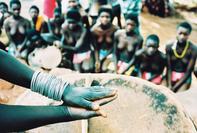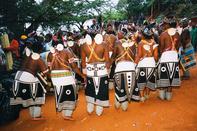Central Part of Venda Life
Music and dance play a central part in Venda life, being performed at weddings and funerals, rituals and initiation schools, beer drinking and gatherings. Dance is also important in independent churches to which many Venda belong.

Some musicians play popular and religious music, but traditional forms are often incorporated into modern compositions. Musical instruments, music, song and dance express status and power and have religious significance.
Many instruments that have disappeared elsewhere in Africa are still used: mbila 'xylophone', mbira 'thumb piano', thsikona 'reed flutes', stringed instruments, mirumba 'treble drums', ngoma 'bass drums' and thungwa - drums like the ngoma, but smaller. Kings had, and still have, a tshikona ensemble, whose ability reflected their power and prestige and, thus, their people's. Ngoma drums, one of the main symbols of kingship, in the past were played only at court.
Very young children are encouraged to imitate adults' songs and dances. When they are bigger, they sing children's songs 'nyimbo dza vhana': nyimbo, simple jingles that are sung during the day, and ngano, during the evening, especially at harvest 'mavhuya-haya'. The latter are story songs, often performed by adults and children of both sexes.
Dzhombo, characterized by display and erotic action, takes place on moonlit nights at mavhuya-haya. Girls and boys face each other and, accompanied by clapping, dance in turn between the lines. The dancer touches a person of the opposite sex to show a preference. The songs are rhythmic and melodic and more complex than nyimbo and ngano.
Main Venda Dances

The main dances performed by young people before marriage are tshikanganga and tshigombela. They are an important part of life, but evidence suggests they are not very old. The tshikanganga is a fast dance in which boys play reed-flutes and girls accompany them on thungwa and mirumba drums. It is performed for pleasure, but permission must be obtained from the headman or king. The tshigombela, for girls, occurs before harvest.
Accompanied by one thungwa and two mirumba drums, a girl begins a song and others join in the chorus; they dance anti-clockwise around the drums, the pitch of the song rising. The malombo dance is the second phase of treatment for a person 'usually female' possessed by a homeless spirit 'tshilombo'.
If a woman falls ill and a diviner indicates the presence of a tshilombo, special treatment is necessary. In the first phase, a specialist 'maine a tshele' brings the woman into a trance, causes her to collapse, treats her with medicines and asks the spirit to identify itself and its wishes.
The spirit is thus introduced into the body of the afflicted woman 'medium', rather than exorcised. In the second phase, the medium joins a society of malombo dancers of previously healed patients. The dance takes place in the khoro 'courtyard' of the king, who lends the society some of his instruments.
The spirit is often male, and possessed women may behave like men, wear male garments - waistcoats, ties and hats - and carry male objects, imitation assegais or miniature axes. This has led to the belief that the malombo cult is an organized movement opposing male superiority.